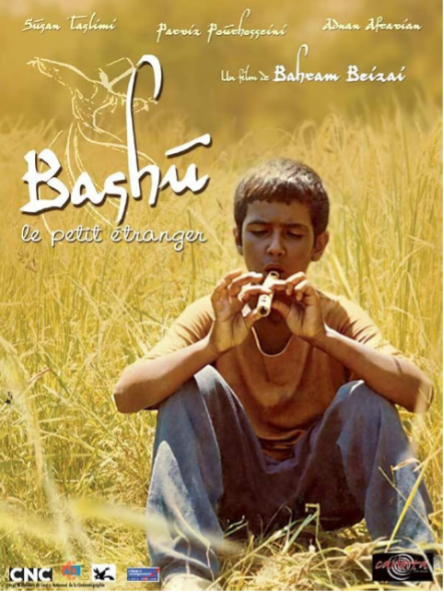
The Child of the Sun and the Earth

Figure 1: Poster for Bashu, The Little Stranger (Bāshū, Gharībah-yi Kūchak), directed by Bahrām Bayzā’ī, 1986. Source: IMDb.
Introduction1The title is derived from a quote in the film: “ū misl-i hamah-yi bachah-hā farzand-i āftāb u zamīn ast” (Like all children, he [Bāshū] is the child of the sun and the earth). Translated by the author. Bashu, The Little Stranger, dir. Bahrām Bayza’ī (Iran, 1986), 01:42:09.
Bāshū, the film’s protagonist, is a young black Arab boy hailing from Khūzistān, located in the southwestern region of Iran. Tragically, he lost his entire family during the devastating bombings of the Iran-Iraq war (1980-1988). Filled with fear and confusion, Bāshū flees through the vast fields until he stumbles upon a truck. Seeking solace, he hides on the back of the truck and eventually drifts into a deep sleep. When Bāshū wakes up, he finds himself in a completely unfamiliar world, a stark contrast from the land he once knew. This new place is the northern part of Iran, adorned with lush green forests and a serene rural atmosphere. With a leap of faith, Bāshū jumps off the truck and ventures into the forest, eventually finding Nā’ī’s paddy field.
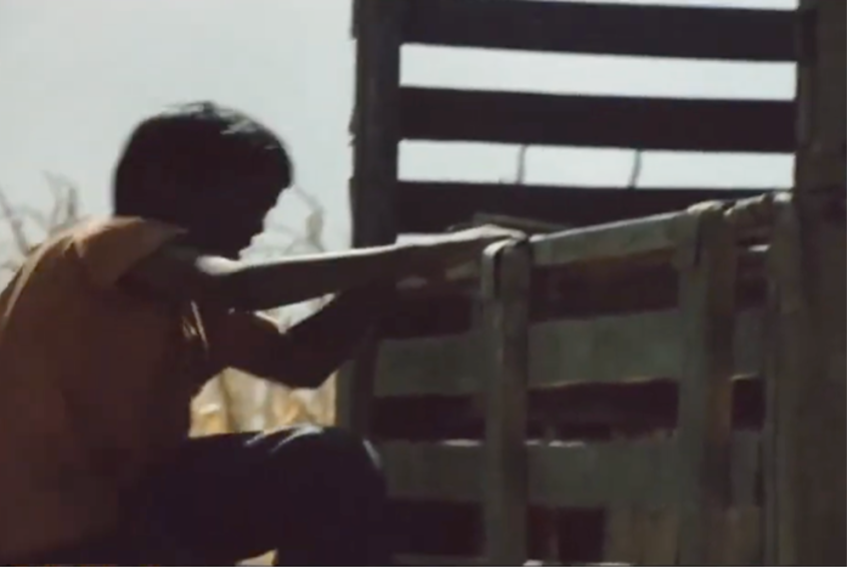
Figure 2: Bāshū jumping into the back of a truck where he falls asleep. Frame enlargement of a screenshot from the film Bashu, The Little Stranger (Bāshū, Gharībah-yi Kūchak), directed by Bahrām Bayzā’ī, 1986 (00:03:48).
Nā’ī, a strong and independent Gīlakī woman, resides there with her two children and a playful dog. Suddenly, Nā’ī’s children spot Bāshū, trembling in the bushes under a small wooden bridge. In an instant the entire screen is filled by a close-up of the concerned face of their mother (Figure 3). Nā’ī’s eyes, framed by the sharp angles of her white scarf, hold a mixture of worry and suspicion. Holding each end of her scarf tightly, she gazes anxiously at her children, then casts a wary glance at the stranger nearby. The intensity and beauty of this tableau linger with viewers throughout the duration of the film.
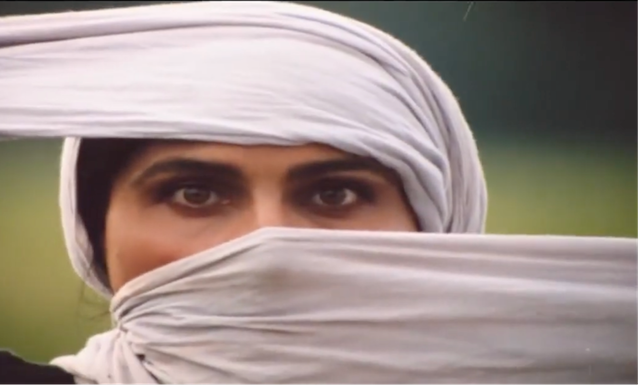
Figure 3: Nā’ī’s close-up after hearing her children call to visit the stranger hidden under the wooden bridge. Frame enlargement from the film Bashu, The Little Stranger (Bāshū, Gharībah-yi Kūchak), directed by Bahrām Bayzā’ī, 1986 (00:11:37).
Although Nā’ī decides to shelter Bāshū in her family, the people of the north are taken aback by the unfamiliar dark color of Bāshū’s skin, which sparks fear and concern upon their first encounter. Nā’ī extends her compassion by offering him rice, bread, and water. Throughout the film Bāshū experiences post-traumatic stress disorder and sees visions of his dead mother (Figure 4). Slowly but surely Nā’ī begins to bridge the gap between them, welcoming Bāshū into her home and caring for him as if he were her own eldest son. As time passes Bāshū’s fearful and rebellious nature subsides, and he wholeheartedly contributes to the household and farm chores.
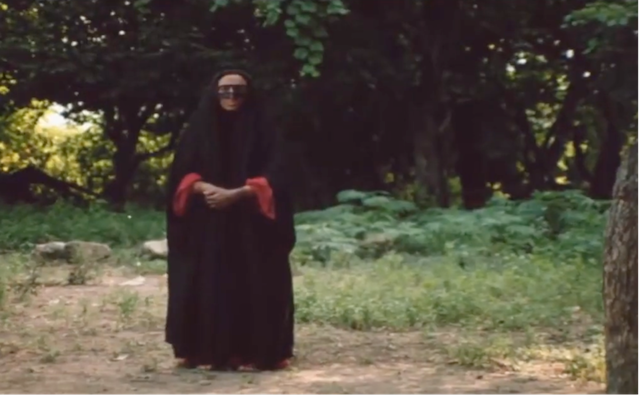
Figure 4: One instance of the vision of Bāshū’s mother, whom he occasionally sees during the film. Frame enlargement from the film Bashu, The Little Stranger (Bāshū, Gharībah-yi Kūchak), directed by Bahrām Bayzā’ī, 1986 (00:23:07).
Despite Nā’ī’s unwavering support, the villagers remain suspicious of Bāshū’s presence. Even the letters received from Nā’ī’s husband express doubts about accepting a mute stranger into their home. Nevertheless, Nā’ī remains vigilant, keeping a watchful eye on Bāshū. Over time they manage to communicate with each other, using a unique blend of Gīlakī, Persian, and Arabic, forming a language that serves as a mediator between them. Towards the end of the movie, Nā’ī’s husband who had apparently left the family for work, returns home, with a lost arm.2Bayzāʼī refrains from explicitly disclosing the whereabouts of the husband, yet the absence of one of his arms hints at his return from the Iran-Iraq war, a topic that, according to authorities within Iran’s Ministry of Culture and Islamic Guidance, should remain concealed. He confronts Nā’ī for keeping Bāshū against his wishes, leading to a tense argument. However, as Bāshū arrives to shield Nā’ī from her husband, he boldly questions, “Who is this man?”3Bashu, The Little Stranger, dir. Bahrām Bayzā’ī (Iran, 1986), 01:51:55. Astonishingly, the husband’s demeanor undergoes an unexpected transformation, and he responds, “father.”4Bashu, The Little Stranger, dir. Bahrām Bayzā’ī (Iran, 1986), 01:52:04. Bāshū asks “Where were you?” and the husband’s answer is heartwarming: “I was looking for you”5Bashu, The Little Stranger, dir. Bahrām Bayzā’ī (Iran, 1986), 01:52:09. Bāshū offers his hand in a handshake, only to notice the father’s missing limb. In that moment their shared experiences of loss and hardship bring them together. This astonishing yet somewhat unbelievable change in the husband’s attitude eradicates the last barrier hindering Bāshū’s complete assimilation into Nā’ī’s chosen family.The film concludes with an exciting scene where the entire family, including the children, run joyfully into the farm field and make loud noises to scare away a troublesome boar. This image symbolizes their unity and resilience in the face of adversity, proving that love and acceptance can triumph over prejudice and war.
Bāshū, the Displaced
The figure of the street boy with a flute in Satyajit Ray’s short Two (1964) resonates intertextually with a kindred presence in Bahrām Bayzāʼī’s feature film of mid-1980s Iran. Both films are about human connection yet while Ray’s short depicts the failure of connection in a hierarchical society, Bayzāʼī goes further to cultivate human connection between two racially, sexually, and ethnically different characters: a boy from southern Iran and a woman from northern Iran. Two is a 12-minute film without dialogue that depicts a contrast between a rich child from a privileged background and a poor child from a slum area in India. The rich child initially enjoys his toys and the comforts of his lifestyle, while the poor street child plays a hand-made flute. The rich boy tries to show off his toys to the poor child through the window of his home, but the poor child responds with his own homemade instruments and toys in the street. The rich child, still unsatisfied, continues playing with his toys, but notices a kite being flown by the poor child. Out of anger and jealousy, the rich child uses his slingshot and air-rifle to shoot down the kite, taunting the poor child. The poor street child, unable to compete, returns home with tears in eyes and a torn kite giving up on trying to be friends with the rich child, while the rich child reflects on his actions as his toy tower falls when we hear the poor child’s flute melodies. As the film was made during the Vietnam war (1954-75), Ray’s short can be seen as a metaphor for the Vietnam War, with the rich child representing the United States and the poor child symbolizing Vietnam. In this case, both Ray’s short and Bayzāʼī’s feature can be seen as anti-war films.
The theme of an outsider who accidentally or purposely ventures into an unknown world and the obstacles they encounter in communication and forming relationships with the locals and the new culture is a recurring theme in literature and cinema. François Truffaut’s L’Enfant Sauvage (1970) adapted from Dr. Jean Marc Gaspard Itard’s novel The Memorandum and Report on Victor de l’Aveyron, explores the challenges and eventually the success of communication between an educator and a boy who spent his preteen years without human contact. So does the adaptation of Michael Blake’s 1988 novel of the same title to the film Dances with Wolves (1990).

Figure 5: Bāshū playing the flute for the scarecrow he created. Frame enlargement from the film Bashu, The Little Stranger (Bāshū, Gharībah-yi Kūchak), directed by Bahrām Bayzā’ī, 1986 (01:45:18).

Figure 6: The street boy playing the flute. Frame enlargement from the film Two, directed by Satyajit Ray, 1964 (00:03:56).
Similarly, Bashu, The Little Stranger explores the experiences of a displaced boy as he tries to adapt to a new culture and language while also highlighting the struggles faced by the villagers in understanding and accepting this outsider. The film’s exploration of the themes of cultural identity and displacement starts and continues with the challenges faced by Bāshū as he grapples with his own identity and the loss of his homeland. Bayzāʼī raises questions about the impact of displacement on one’s sense of self and the search for a place to call home. The language barrier between Nā’ī and Bāshū can be seen in the film’s first half, in which Bāshū and Nā’ī do not understand each other’s language and yet, ambiguously, communicate through Bāshū’s feeling of loss and Nā’ī’s feelings of motherhood and compassion.
Nā’ī possesses a unique ability to connect with nature, effortlessly communicating with the non-human such as birds.6Bashu, The Little Stranger, dir. Bahrām Bayzā’ī (Iran, 1986), 00:21:17. However, Nā’ī finds it unexpectedly challenging to communicate with Bāshū, whose Khūzistāni dialect is initially incomprehensible. Through empathy and creative nonverbal strategies, she eventually becomes a bridge between southern and northern Iranian cultures. For example, she gestures and models eating with bread and rice to teach him proper eating manners in Gīlān, and exchanges objects like a buckle and an egg to establish shared understanding.7Bashu, The Little Stranger, dir. Bahrām Bayzā’ī (Iran, 1986), 00:15:42, 00:29:41. Nā’ī also comforts Bāshū during flashbacks of his war-stricken mother, providing emotional grounding that helps him integrate into her household.8Bashu, The Little Stranger, dir. Bahrām Bayzā’ī (Iran, 1986), 00:23:07. Her consistent care facilitates Bāshū’s gradual acceptance by her children too. These moments of patience, creativity, and human connection gradually break down ethnic and linguistic barriers, highlighting the film’s portrayal of cross-cultural empathy and inclusion.
Bāshū’s sense of displacement is reinforced through Bayzā’ī’s use of contrasting landscapes, from the war-torn south to the lush serenity of the Gīlakī village. However, these contrasts are not merely aesthetic; they expose how race, language, and geography intersect to mark Bāshū as an outsider. Situating the film within critical race theory emphasizes how racial difference is socially constructed, how it functions to uphold hierarchies of power, and how it is embedded in ordinary, everyday interactions.9Richard Delgado and Jean Stefancic, Critical Race Theory: An Introduction, 3rd ed. (New York: NYU Press, 2017), 7–10. Bayzā’ī dramatizes precisely this ordinary, systemic racism when the Gīlakī villagers ridicule Bāshū for his dark skin, calling him a siyāh-sūkhtah (“burnt black”) and treating his difference as a threat to communal purity. This hostility reflects what critical race theory scholars describe as “everyday racism,” the normalized practices through which dominant groups sustain exclusion without necessarily invoking formal institutions.10Richard Delgado and Jean Stefancic, Critical Race Theory: An Introduction, 3rd ed. (New York: NYU Press, 2017), 8–9. Bāshū’s racialization is intensified by his linguistic difference: his Khūzistāni dialect, incomprehensible to the Gīlakī speakers, positions him as doubly alien. Language here functions as what critical race theory terms a “racial signifier”—a marker of belonging that polices the boundary between insider and outsider.11Richard Delgado and Jean Stefancic, Critical Race Theory: An Introduction, 3rd ed. (New York: NYU Press, 2017), 25-26.
At the same time, Bayzā’ī complicates this exclusion by showing how race is not fixed but negotiated. Nā’ī, through acts of care and embodied recognition, challenges the villagers’ prejudice and models what critical race theory scholars call “counter-storytelling” ⸺disrupting dominant narratives by centering the perspective of the marginalized.12Richard Delgado and Jean Stefancic, Critical Race Theory: An Introduction, 3rd ed. (New York: NYU Press, 2017), 43. Bāshū’s survival, then, is not only a personal triumph but a critique of ethnolinguistic nationalism and racial hierarchy in Iran. By embedding these tensions within the domestic sphere of Nā’ī’s household, Bayzā’ī reveals how systemic racism is reproduced at the most intimate level, yet also how resistance can emerge from within. Upon Bāshū’s arrival in Gīlān, he comes face to face with Nā’ī and the new community, who are taken aback and struggle to comprehend Bāshū’s mere presence. In a community where the elders and the supposedly wise believe Nā’ī should not keep and support a stranger who is different, Nā’ī’s empathy triumphs and fosters acceptance, challenging the locals’ narrow sense of community. Several members of the community visit Nā’ī’s house, they attempt to dissuade her from sheltering Bāshū, for example, a woman states “My brother (Nā’ī’s husband) went to look for work, and you bring another mouth to feed?”.13Bashu, The Little Stranger, dir. Bahrām Bayzā’ī (Iran, 1986), 00:35:35. However, Nā’ī’s intervention symbolically represents a strong female agency, going beyond the typical motherly love for a boy. A particularly touching scene showcases Nā’ī’s attempt to communicate with Bāshū by exchanging everyday items, like eggs and a buckle, to find their equivalents in his language.14Bashu, The Little Stranger, dir. Bahrām Bayzā’ī (Iran, 1986), 00:29:41.
In their first encounter with Bāshū when visiting Nā’ī’s house, all the villager guests discourage Nā’ī for sheltering a stranger. They view him as an enigma, comparing him to a smoke blackened lamp, labeling him a thief, and associating him with bad fortune.15Bashu, The Little Stranger, dir. Bahrām Bayzā’ī (Iran, 1986), 00:32:17, 00:32:43. However, after a few minutes, Nā’ī defends Bāshū and asks them all to leave her house. The stark contrast between Nā’ī’s affection and empathy and the villagers’ lack thereof highlights the villagers’ inability to comprehend Bāshū’s skin color. In one scene, desperate to rid him of his darkness, Nā’ī attempts to scrub away his blackness using soap and water, hoping to transform him into a clean, white entity (Figure 7).16Bashu, The Little Stranger, dir. Bahrām Bayzā’ī (Iran, 1986), 00:52:00. For a critical discussion of race in Bāshū, see: Zavier Wingham, “Blackness on the Iranian Periphery: Ethnicity, Language, and Nation in Bashu, The Little Stranger,” Ajam Media Collective, September 23, 2015. https://ajammc.com/2015/09/23/blackness-on-the-iranian-periphery/ Nā’ī’s actions reveal her willingness to challenge the status quo and support Bāshū, even if it goes against the norms of her community. However, the fact that Nā’ī also attempts to change Bāshū’s physical appearance suggests that she, too, is not immune to the community’s institutionalized biases.

Figure 7: Nā’ī uses water and soap to wash away Bāshū’s skin color. Frame enlargement of a screenshot from the film Bashu, The Little Stranger (Bāshū, Gharībah-yi Kūchak), directed by Bahrām Bayzā’ī, 1986 (00:52:00).
Fertility and Zār Rites
In his later film Travelers (Musāfirān, 1991), Bayzāʼī demonstrates the significance of fertility and its associated rituals. Ac accordingly, during a conversation with Nūshābah Amīrī, He believes that “Travelers is a film about fertility, which may be what all my films are about: creation, fertility, and rebirth.”17Nūshābah Amīrī, Jidāl Bā Jahl [Fight Against Ignorance: A Conversation with Bahrām Bayzāʼī] (Tehran: Sālis Publication, 2013), 95. Translated by the author. This highlights his recurring exploration of fertility as a central theme. Rituals can be pivotal performances in human communities to encourage collective cohesion and to support life-affirming themes such as fertility and the reduction of anxiety and fear during uncertain times or crises by fostering a sense of connection and support. They can also provide a sense of control over the surroundings. Furthermore, rituals bring people together to celebrate important life milestones, strengthening bonds with friends, family and other members of the community. Specifically, they act as a social glue during times of displacement and adversity as they provide continuity, stability, and a sense of belonging.18For more discussion on rituals and their relationship to reducing anxiety and fear see: M. Lang, J. Krátký and D. Xygalatas, “The role of ritual behaviour in anxiety reduction: an investigation of Marathi religious practices in Mauritius,” Philosophical Transactions of the Royal Society Publishing 375, no. 1805 (June, 29, 2020), https://doi.org/10.1098/rstb.2019.0431 Meanwhile, rituals serve as a cultural expression and manifestation of the sacred and provide a means for humans to connect with the transcendent. Although Bāshū is unfamiliar with the Gīlakī dialect and culture, he can communicate through Shamanistic media such as Zār and fertility rites, in addition to Persian as the communal language of the diverse ethnicities in Iran.
Bāshū as Shaman/Minoritarian
According to the historian of religion Mircea Eliade, Shamanism principally developed in northern and central Asia and in North America, includes various categories of medicine men and wizards who flourish in other primitive societies.19Shamanism is a consciousness, spirituality, and healing discipline and practice that encompasses a range of beliefs and practices found in various cultures around the world. It involves individuals, known as shamans, who are believed to have the ability to communicate with spirits, including ancestors, nature spirits, and deities. They often enter altered states of consciousness through various techniques such as drumming, chanting, dancing, or the use of hallucinogenic substances to establish a connection with the spirit world. It is important to note that shamanism is a diverse and complex practice, and its specific beliefs and practices can vary greatly across different cultures and regions. According to anthropological studies, the emergence of a shamanic vocation is frequently precipitated by an accident or an extraordinary event. Among the Buriat, the Soyot, or the Eskimos, the path may begin after being “struck by lightning,” falling from a “high tree,” or by enduring a particularly arduous “ordeal.” As Mircea Eliade notes, the initiation of the shaman is rarely a gradual process of learning alone but often involves a dramatic rupture in the individual’s ordinary existence. Central to this rupture is the presence of a deep “crisis,” one so extreme that it can border on “madness.” However, it is precisely this experience of disintegration that provides the grounds for transformation. The youth cannot become a shaman until he has confronted and resolved the depth of this inner crisis, which ultimately functions as a form of “mystical initiation.”20Mircea Eliade, Shamanism: Archaic Techniques of Ecstasy, trans. Willard R. Trask (Princeton: Princeton University Press, 1964), 33–35; See also Mircea Eliade, Rites and Symbols of Initiation: The Mysteries of Birth and Rebirth, trans. Willard R. Trask (New York: Harper Colophon Books, 1975): 87-88.
While the Dihkhudā dictionary defines the word Bāshū as chalpāsah, the Persian equivalent to lizard,21See “Bāshū,” in Vajehyab, accessed September 15, 2025, https://vajehyab.com/dehkhoda/باشو. it is crucial to examine the significance of the name Bāshū within its unique geographical and cultural framework. For example, in Kirmāni dialect (Southeast of Iran) the word Bāshū always refers to grandfather. The Name Bāshū, drawn from the dialect of the southern Khūzistān, means “Be”-a plea to God by parents for their child’s preservation.22See “Bāshū,” in Gahvare, accessed September 15, 2025, https://gahvare.net/names/باشو. Therefore, Bayzāʼī’s naming has symbolic weight: as Bāshū flees the devastation of war and seeks refuge in northern Iran, his very survival embodies the imperative of “being” (staying alive) in the face of violence.
Arguably, Bāshū’s survival works as a passing process of initiation into a Shaman entity. He is supposed to “be” to transfer his healing and reconciling power to Nā’ī’s family who are missing the father. In this regard, Bāshū’s survival of war and dislocation can be read as such an initiation, a passage into a liminal state that equips him with a shamanic dimension. His role is not simply that of a child refugee but of a figure whose presence channels healing and reconciliation into Nā’ī’s fractured household, which has lost its paternal anchor. Bāshū’s shamanship becomes evident in his ritual acts: the crafting of the scarecrow, the playing of the flute to animate it, his evocation of Zār and fertility rites, and ultimately the climactic scene where, alongside Nā’ī and her children, he drives away the invading boar. In this sense, Bayzāʼī uses Bāshū’s shamanic role not only to dramatize resilience but also to critique ethnic exclusion, superstition, and patriarchal structures, suggesting that cultural renewal can emerge precisely from the margins of society.23Erika Friedl, Women of Deh Koh: Lives in an Iranian Village (Washington, DC: Smithsonian Institution Press, 1989), 142–47.

Figure 8: Frame enlargement of a screenshot from the film Bashu, The Little Stranger (Bāshū, Gharībah-yi Kūchak), directed by Bahrām Bayzā’ī, 1986 (01:45:26).
Shamanism, being one of the oldest systems of human healing and ritual practice, can be seen as a form of consciousness, spirituality, and healing discipline, as it encompasses all of these aspects.24Roger N. Walsh, The World of Shamanism: New Views of an Ancient Tradition (Llewellyn Publications, 2007), 16. According to Claude Lévi-Strauss, the French structuralist anthropologist, “The shamanistic complex” is built upon the experiences of the shaman, the effects on the sick individual, and the involvement of the community. These elements are interconnected and revolve around the shaman’s personal experiences and the consensus of the group. This creates a transformative reality that combines personal healing, collective support, and unknown possibilities. When treating a patient, the shaman also presents a performance to the audience. This performance typically involves the shaman reenacting the “call” or the initial crisis that led to their revelation of their condition.25Claude Lévi-Strauss, Structural Anthropology, trans. Claire Jacobson and Brooke Grundfest Schoepf (New York: Basic Books, 1963), 180. By doing so, the shaman, aided by their guiding spirits, embarks on a journey to the supernatural realm to retrieve the captured spirit and restore it to its rightful owner, thus achieving a cure.26Claude Lévi-Strauss, Structural Anthropology, trans. Claire Jacobson and Brooke Grundfest Schoepf (New York: Basic Books, 1963), 188.
Notably, Bāshū’s reality is haunted by dark surrealism of his vision of his war-stricken mother (Figure 9). These spectral apparitions, delicately woven into the realistic fabric of the film, contribute to nuances of magical realism in the film, further amplified by the rituals of fertility and the mystical Zār ceremonies. In addition, the vision of Bāshū’s mother can be seen as the equivalent of what Lévi-Strauss refers to as “tutelary spirits” that assist and guide the shaman in their endeavors. Therefore, the shamanistic cure and the psychotherapeutic cure can be seen as parallel concepts.27Claude Lévi-Strauss, Structural Anthropology, trans. Claire Jacobson and Brooke Grundfest Schoepf (New York: Basic Books, 1963), 201. The modern version of shamanistic technique, known as psychotherapy, derives its unique characteristics from the fact that mythical time no longer exists in industrial civilization, except within the individual themselves. Psychoanalysis can find validation and strengthen its theoretical foundations by comparing its methods and goals with those of its predecessors, the shamans and sorcerers.28Claude Lévi-Strauss, Structural Anthropology, trans. Claire Jacobson and Brooke Grundfest Schoepf (New York: Basic Books, 1963), 204.
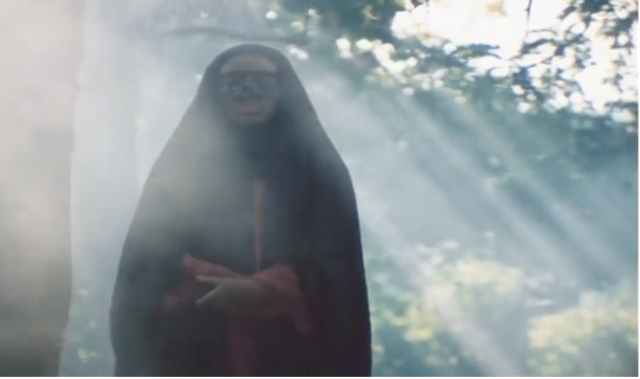
Figure 9: Frame enlargement of a screenshot from the film Bashu, The Little Stranger (Bāshū, Gharībah-yi Kūchak), directed by Bahrām Bayzā’ī, 1986 (00:57:43).
Bāshū embodies folk rituals, oral traditions, and healing practices tied to marginalized ethnic cultures—what Deleuze might call “minor” traits—that, despite his displacement, enable him to communicate with and adapt to his new environment. Bāshū’s transfiguration directly engages with rites of fertility and Zār, particularly when Nā’ī falls ill and requires healing.29Gilles Deleuze and Félix Guattari, Kafka: Toward a Minor Literature, trans. Dana Polan (Minneapolis: University of Minnesota Press, 1986), 16–18. As Nā’ī lies in bed, drenched in sweat, Bāshū starts performing Zār and his drumbeats guide Nā’ī’s body into a rhythmic movement. When Bāshū starts singing and dancing in Nā’ī’s farm, the same local children ask him about what he is doing. His response is quite illuminating: “plants grow better with this sound”30Bashu, The Little Stranger, dir. Bahrām Bayzā’ī (Iran, 1986), 01:23:29. (Figure 10), which he repeats in response to Nā’ī’s husband in his first meeting with Bāshū at the end of the film.31Bashu, The Little Stranger, dir. Bahrām Bayzā’ī (Iran, 1986), 01:48:11. Other kids are astonished to the extent that they approach him to join his fertility rituals (Figure 11).32Bashu, The Little Stranger, dir. Bahrām Bayzā’ī (Iran, 1986), 01:23:50. Similarly, Bāshū starts playing the flute for the scarecrow and for the plants as if breathing life into the inanimate scarecrow and the plants to stand guard over the farm.33Bashu, The Little Stranger, dir. Bahrām Bayzā’ī (Iran, 1986), 01:45:17. Bāshū can be seen as the Shaman who transfers the seasonal blessing to Nā’ī’s farm through fertility rites performed by him using ethnic music and body movements to ensure the continuation of the life-cycle.
The way Bāshū carries the harvest resembles the practices of shamans. His flute-playing, intended to accelerate the growth of greens, becomes a shamanistic language that allows him to challenge the dominant Gīlakī culture while bridging his own ethnic modes of communication with those of northern Iran. Bāshū is also a creator, making a scarecrow to protect Nā’ī’s harvest and singing, dancing, and playing drums on various occasions, whether to heal Nā’ī’s illness or to fertilize the crops.
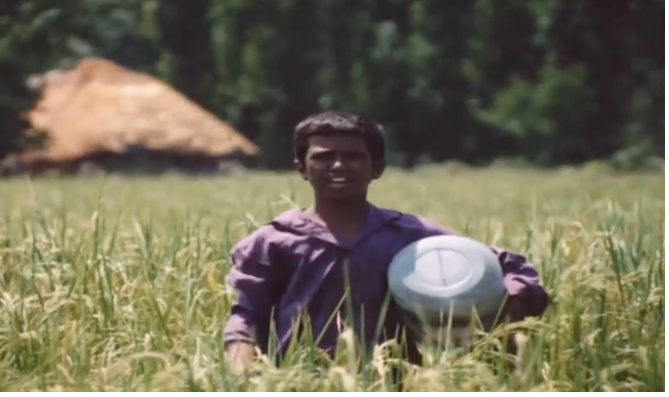
Figure 10: Bāshū playing the drum to help the plant grow better. Frame enlargement of a screenshot from the film Bashu, The Little Stranger (Bāshū, Gharībah-yi Kūchak), directed by Bahrām Bayzā’ī, 1986 (01:23:29).
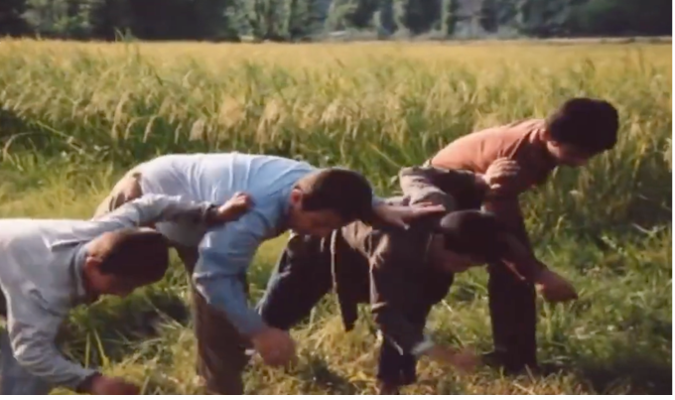
Figure 11: Other kids joining Bāshū in fertility rituals. Frame enlargement of a screenshot from the film Bashu, The Little Stranger (Bāshū, Gharībah-yi Kūchak), directed by Bahrām Bayzā’ī, 1986 (01:23:50).
The shaman goes beyond simply imitating or reenacting performances; instead, he fully experiences them with all their intensity, authenticity, and brutality. Similar to the concept of abreaction in psychoanalysis, the shaman relives the original situation that caused the disturbance before ultimately overcoming it. Therefore, the shaman can be seen as a professional abreactor—someone who facilitates the intense reliving and resolution of traumatic experiences during ritual or ceremonial sessions, where the shaman aims to communicate with the spirit world, seek guidance, heal illness, or mediate between humans and spirits (which is called séance).34Claude Lévi-Strauss, Structural Anthropology, trans. Claire Jacobson and Brooke Grundfest Schoepf (New York: Basic Books, 1963), 181. The healing process of Zār holds great significance and connection to shamanic and religious practices.35In another article on Mānī Haqīqī’s film A Dragon Arrives (2016), I explored and discussed Zār as a healing rite. See M. Behnam, “A Dragon Arrives! (2016).” In Cinema Iranica. Encyclopaedia Iranica Foundation https://cinema.iranicaonline.org/article/a-dragon-arrives-azhdaha-varid-mishavad/. Bāshū can be perceived as a vibrant embodiment of the energy of life and its vitality as his name connotates “Be.” Despite his bold strangeness to the local culture, Bāshū embodies a form of imaginative connection with Nā’ī and her farm.
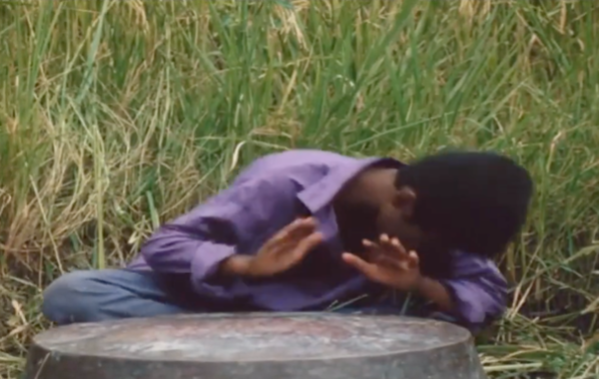
Figure 12: Bāshū playing the Zār drum to heal Nā’ī, who is suffering from fever. Frame enlargement of a screenshot from the film Bashu, The Little Stranger (Bāshū, Gharībah-yi Kūchak), directed by Bahrām Bayzā’ī, 1986 (01:39:48).
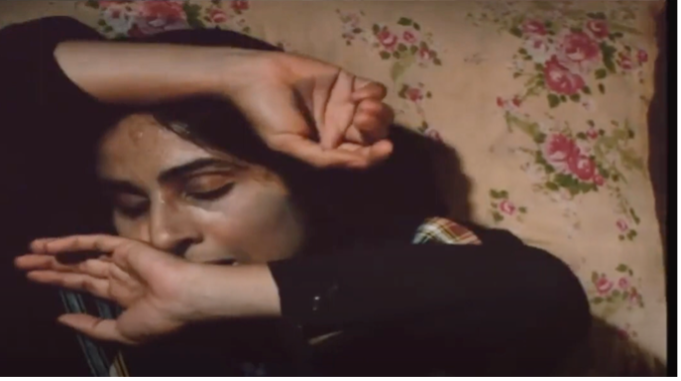
Figure 13: Nā’ī struggling with illness and fever. Frame enlargement of a screenshot from the film Bashu, The Little Stranger (Bāshū, Gharībah-yi Kūchak), directed by Bahrām Bayzā’ī, 1986 (01:38:02).
Notably, Bayzāʼī is an artist of the Bahá’í faith36The Bahá’í Faith is a monotheistic religion that originated in the 19th century in Persia (modern-day Iran). It was founded by Bahá’u’lláh (1817–1892), a prophet and spiritual leader, who is considered by Bahá’ís to be the latest in a line of messengers from God that includes figures like Abraham, Moses, Buddha, Jesus, and Muhammad. For more discussion, see: Moojan Momen, The Bahá’í Faith: A Beginner’s Guide (Oneworld Publications, 2008). and “a fiercely secular and oppositional director used to working in a type of unofficial internal exile, about which he regularly complained but which actually powered his movies.”37Hamid Naficy, A Social History of Iranian Cinema. Vol. 4, The Globalizing Era, 1984-2010 (Durham, N.C.: Duke University Press, 2012), 38. Bayzāʼī can be considered a minor filmmaker who, unfortunately, faced the wrath of both the Pahlavī and Islamic Regimes, rendering his influence in the art and industry of filmmaking in Iran. However, his collection of creative works truly encapsulates his singular perspective as a member of a minority group. As a secular artist of the Bahá’í faith, Bayzāʼī’s films and his unwavering defiance against oppressive authorities have transformed his cinema and body of work into a testament of authorship, courage and resilience. In Bāshū, Bayzāʼī uses two distinct dialects—Khūzistāni and Gīlakī—within the Persian-language film to create a nuanced, sometimes disrupted, form of communication. This linguistic strategy contributes to the film’s positioning as minor cinema, as it establishes a symbolic and allegorical language that diverges from the dominant Persian tradition. By juxtaposing these dialects, Bayzāʼī complicates conventional modes of communication, a tension that is collectively enacted when other boys gather around Bāshū as he reads from a Persian schoolbook (Figures 15 & 16).
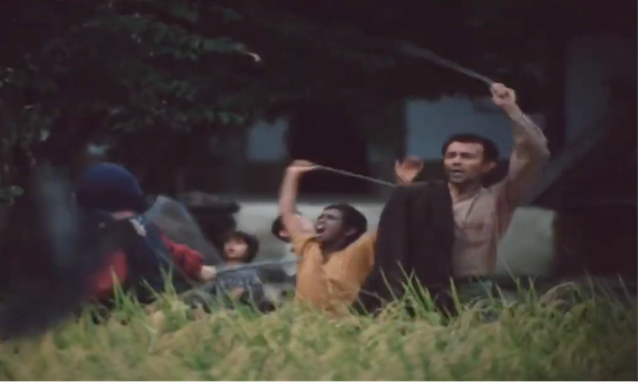
Figure 14: Frame enlargement of a screenshot from the film Bashu, The Little Stranger (Bāshū, Gharībah-yi Kūchak), directed by Bahrām Bayzā’ī, 1986 (01:54:03).
Bāshū explores and displays the delicate threads that bind a diverse nation together, explicitly emphasizing the significance of Persian as the official language. At some point Bāshū, being unfamiliar with the local dialect, can only interact with the village children through the formal school book of Persian Literature. In a scene where he attempts to read aloud from a school textbook taken from the ground, he reads from the pages proclaiming, “Iran is our homeland. We are nurtured by the same water and land. We are the children of Iran” (Figure 15).38Bashu, The Little Stranger, dir. Bahrām Bayzā’ī (Iran, 1986), 00:58:32. Suddenly in this heart melting scene, all other boys who used to humiliate Bāshū due to his skin color and lack of linguistic communication, gather around him attentively paying attention to what he says while being curious about his past and how he has learned Persian. As Hamid Naficy explains “His [Bāshū’s] knowledge of the formal Persian suddenly dissolves all the hostility.”39Hamid Naficy, A Social History of Iranian Cinema. Vol. 4, The Globalizing Era, 1984-2010 (Durham, N.C.: Duke University Press, 2012), 37. In addition to Persian language as the unifying element between Nā’ī and Bāshū, the epistolary relationship between them, although indirect, is another element that proposes reconciliation.40Hamid Naficy, A Social History of Iranian Cinema. Vol. 4, The Globalizing Era, 1984-2010 (Durham, N.C.: Duke University Press, 2012), 37. Similarly, when Nā’ī’s husband is absent, her sole means of communication with him is limited to Persian, despite her illiteracy. While Persian serves as a means of communication, it does not guarantee comprehension or complete inclusion for all ethnicities involved; However, it is displayed as a foundation for national unity yet simultaneously highlighting individual differences.
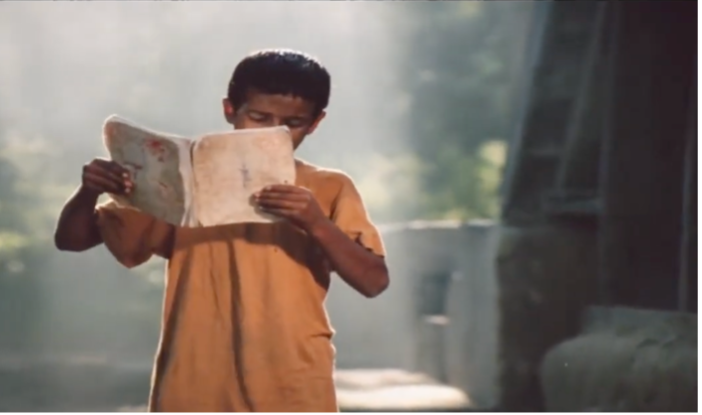
Figure 15: Bāshū finds a Persian educational book and reads a touching passage, which makes the other children sympathize with him. Frame enlargement of a screenshot from the film Bashu, The Little Stranger (Bāshū, Gharībah-yi Kūchak), directed by Bahrām Bayzā’ī, 1986 (00:58:38).

Figure 16: The other children unexpectedly gather around Bāshū to hear his story. Frame enlargement of a screenshot from the film Bashu, The Little Stranger (Bāshū, Gharībah-yi Kūchak), directed by Bahrām Bayzā’ī, 1986 (00:58:52).
The title Bashu, The Little Stranger foregrounds the protagonist’s dual condition of estrangement and marginality: the term “stranger” signals his unfamiliarity and displacement, while the qualifier “little” underscores both his vulnerability as a child and his minority status. Bāshū’s position, however, extends beyond mere otherness; he exemplifies what Deleuze and Guattari theorize as the “minor,” a mode of existence marked not by numerical scarcity but by transformative potential. As Verena Conley observes in The Deleuze Dictionary, “a minority is not defined by the paucity of its numbers but by its capacity to become or, in its subjective geography, to draw for itself lines of fluctuation that open up a gap and separate it from the axiom constituting a redundant majority.”41Verena Conley, “Minoritarian,” in The Deleuze Dictionary, ed. Adrian Parr (Edinburgh University Press, 2010), 167. In this sense, Bāshū embodies in-betweenness and interculturality, articulating a new language of empathy, love, and connection that develops between himself and Nā’ī. His shamanistic performances—building a scarecrow, animating it with music, and channeling healing rituals—constitute practices of minor expression that resist assimilation to dominant cultural codes. For Deleuze and Guattari, minor literature (and, by extension, minor cinema) arises from marginalized or exilic positions and destabilizes hegemonic narratives by employing subversive forms of language and representation.42Gilles Deleuze and Félix Guattari, Kafka: Toward a Minor Literature, trans. Dana Polan (Minneapolis: University of Minnesota Press, 1986), 18. Bāshū’s presence within Nā’ī’s household, therefore, stages a minoritarian encounter, a reconfiguration of kinship and community that challenges both ethnic exclusion and patriarchal authority through acts of care and ritualized solidarity.
The notion of the minor is crucial for understanding the cultural and political stakes of Bahrām Bayzāʾī’s film, however yet its meaning must be situated carefully. Minor does not signify smallness of audience or peripheral importance, but rather a structural position vis-à-vis the dominant, a position that unsettles linguistic, cultural, and political hierarchies. Deleuze and Guattari’s theorization of “minor literature” provides a productive entry point. For them, minor literature is marked by three interlocking features⸺the deterritorialization of language, the imbrication of the individual with political immediacy, and the emergence of a collective assemblage of enunciation. This model helps illuminate how Bāshū mobilizes minoritarian expression, while also pointing to the limits of literary theory when translated into filmic practice.
In Bayzāʾī’s film, Bāshū’s Khūzistāni Arabic and Persian dialect are deterritorialized within the Gīlakī-speaking north, producing a radical linguistic estrangement. This estrangement pushes him to rely on ritual, gesture, and affect—forms of communication that exceed spoken language. At the same time, his displacement from the war-torn south to the rural north embodies the second element of the minor: his individual predicament is inseparable from the political trauma of the Iran-Iraq war. His very presence in Nā’ī’s household becomes a living index of the nation’s fractures. Finally, Bāshū’s gradual recognition by Nā’ī and the Gīlakī children enacts the collective dimension of the minor. When the children gather around him as he reads from a Persian text, the scene stages not assimilation into the major language, but rather the possibility of a collective enunciation forged through difference and negotiation.
Bayzāʾī underscores this minoritarian condition through his cinematic form. By deliberately withholding subtitles when Bāshū speaks Khūzistāni Arabic,43Bashu, The Little Stranger, dir. Bahrām Bayzā’ī (Iran, 1986), 00:23:22. he positions the audience in the same situation as the villagers ⸺confronted with incomprehensibility and forced to acknowledge the exclusions created by linguistic dominance. This refusal prevents Bāshū’s language from being fully domesticated into the dominant Persian and instead makes the viewer inhabit the discomfort of the minor. In this sense, Bayzāʾī’s film is not only about a minor subject; it is itself a minor practice of cinema—one that destabilizes the authority of the dominant language and foregrounds marginalized expression as a site of aesthetic and political power. When considered alongside other postcolonial works such as Ousmane Sembène’s Black Girl (1966), Bāshū demonstrates how the “minor” exceeds literary categories and can be rethought as a transmedial strategy of cultural resistance. Both films show that minor expression does not merely depict the marginalized, but also restructures how audiences experience language, silence, and power. Another example of minor agencies in cinema can be found in films like Barry Jenkins’s Moonlight (2016), which challenges dominant narratives by giving a voice to a marginalized character ⸺a gay black individual navigating the complexities of race, sexuality, and class, the struggles faced by individuals at the intersection of these identities.
Despite all linguistic and ethnic differences between Nā’ī and Bāshū, they both manage to build a mutual bond through their individual abilities and ethnic characteristics. For example, the healing process is mutual as Nā’ī has already helped Bāshū heal when he suffered from fever by giving him medicinal syrup.44Bashu, The Little Stranger, dir. Bahrām Bayzā’ī (Iran, 1986), 00:40:45. Similarly, towards the end of the film where Bāshū feels more at home with Nā’ī, he helps him with farming tasks and even with feeding her two children when Nā’ī is ill. At some point, Bāshū extends the influence of Nā’ī as a mother figure by imitating her and communicating with birds.45Bashu, The Little Stranger, dir. Bahrām Bayzā’ī (Iran, 1986), 01:28:55.
Anti-Oedipal?
Bayzāʼī’s depiction of the dynamic between Bāshū, Nā’ī and her husband Hūshang complicates our understanding of their relationship. Although the film does not directly explore the Oedipal aspects, it offers a genuine portrayal of the bond between a woman and a young boy in the context of a war-torn society by portraying the nurturing relationship between the two characters as Nā’ī becomes a maternal figure to Bāshū, providing him with love, care, and protection.
To understand the husband’s relationship to Bāshū, it is essential to theorize how the film uses symbolic absence—specifically, (Nā’ī’s husband) Hūshang’s missing arm—to structure power, masculinity, and the dynamics of presence and substitution. Although Hūshang only appears on screen near the film’s conclusion (approximately the last 10 minutes, following Bāshū’s symbolic integration into the household through farming and ritual labor),46Bashu, The Little Stranger, dir. Bahrām Bayzā’ī (Iran, 1986), 01:47:32 onward. his missing arm is foreshadowed not by explicit depiction but by discursive absence and by the household’s balance of care and responsibility. Bāshū comes to function as the family’s missing father before the husband’s onscreen return. Therefore, Bāshū’s role is symbolically anticipated in how he performs labor, nurturance, and relational presence in Nā’ī’s household prior to the husband’s appearance. When Hūshang does appear, the symbolic function of the missing arm becomes explicit. The dialogue—his asking Bāshū for water, Bāshū’s astonished gaze, and his remark, “You appear to be a stranger”47Bashu, The Little Stranger, dir. Bahrām Bayzā’ī (Iran, 1986), 01:47:50.—illustrates not just Bāshū’s otherness but also how Bāshū has already become a mirrored absence through which the missing masculine power is made visible. The mise-en-scène includes the scarecrow in the background (Figure 17),48Bashu, The Little Stranger, dir. Bahrām Bayzā’ī (Iran, 1986), 01:47:32. which visually parallels Hūshang’s disfigurement: a hollow, “puppet”-like figure, evoking impotence and a hollow authority. Furthermore, when Hūshang remarks, “You have a Lolo (scarecrow) too,” Bāshū’s response catches him off guard as he confidently declares, “I made it … Is there something wrong with that?” Hūshang’s reply, “its hands,” symbolically addresses his missing arm,49Bashu, The Little Stranger, dir. Bahrām Bayzā’ī (Iran, 1986), 01:48:20. which Bāshū notices a few minutes later when he offers him a hand-shake (Figure 18). Therefore, while the film does not show Hūshang’s missing arm until his reappearance, it does prepare the audience (through narrative, symbolism, and relational labor) to see Bāshū as filling—before the husband’s actual presence—the void created by that absence. When the husband finally appears, the void is enacted, confronted, and partially resolved in their encounter.
Meanwhile, Hūshang’s reappearance functions less as the restoration of patriarchal order than as a narrative of the new, fragile community that Nā’ī and Bāshū have constructed. His arrival momentarily destabilizes the household ⸺the dominant expectation is that the patriarch will disapprove of the outsider child, reinforcing the very communal hostility voiced earlier in the film. Instead, his acceptance of Bāshū, understated and non-verbal, closes the film by ratifying the minor, shamanistic family structure that has emerged in his absence. Therefore, Hūshang’s return does not overwrite Bāshū’s displacement but rather reframes it within the broader narrative of war, migration, and cultural negotiation. In this sense, his arrival — deferred until the narrative resolution — underscores the centrality of Bāshū and Nā’ī’s relationship: the war-torn child and the rural mother create a new social unit before the patriarch re-enters the scene.
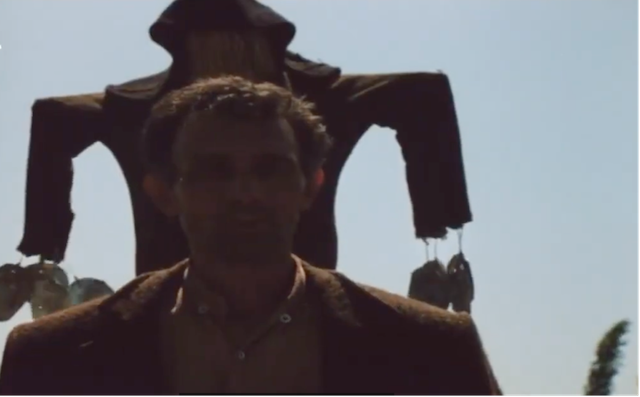
Figure 17: Bāshū’s first encounter with Nā’ī’s husband, which parallels him to the scarecrow. Frame enlargement of a screenshot from the film Bashu, The Little Stranger (Bāshū, Gharībah-yi Kūchak), directed by Bahrām Bayzā’ī, 1986 (01:47:32).

Figure 18: Bāshū suddenly notices that Nā’ī’s husband has lost his arm after offering him a hand-shake. Frame enlargement of a screenshot from the film Bashu, The Little Stranger (Bāshū, Gharībah-yi Kūchak), directed by Bahrām Bayzā’ī, 1986 (01:52:29).
Conclusion
In his deeply moving narrative, Bayzāʼī skillfully captures the genuine human connection between a woman and a young boy amidst the backdrop of Iran ravaged by war in the 1980s. Bashu, The Little Stranger delicately explores themes of displacement, identity, and the power of human connection, while also addressing the universal yearning for belonging across cultural boundaries with specific ethnic diversity in Iran. The story revolves around Bāshū, a figure who embodies both a marginalized and shamanic presence. Through his introduction of healing rituals and fertility practices, such as Zār and fertility rites, Bāshū adds a sense of healing and vitality into Nā’ī’s world which was already filled with her life-affirming manner. As they embark on a transformative journey together, love and empathy gradually bridge the gap between these two characters, enriching their lives. Bayzāʼī, a master of traditional performing arts and rituals, skillfully incorporates the enchanting customs of Iran’s southern region, examining their minoritarian significance within the context of northern Iran. The interethnic experience of Bāshū is seen and felt in the ethnically colorful background of Iran, creating a visually captivating and emotionally resonant film.
Bashu, The Little Stranger was released with a delay of three years due to Bayzai’s refusal to make some eighty-five changes demanded by the official censors, including the removal of the remarkable close-up shot of Taslīmī at the beginning of the film.50Hamid Naficy, A Social History of Iranian Cinema. Vol. 4, The Globalizing Era, 1984-2010 (Durham, N.C.: Duke University Press, 2012), 141. It is evident that Bayzāʼī’s personal struggles with censorship, as informed by the oppressive power structure that has attempted to undermine his creative works across decades of creative practice, can be interpreted as social and political in nature. However, Bayzāʼī’s peculiar style and resilience subverted these could-be-disappointing restrictions and hostility.
Cite this article

Bahrām Bayzā’ī’s Bashu, the Little Stranger (1986/1989) stands as a landmark in Iranian cinema for its radical reworking of displacement, ethnicity, and ritual as sites of survival and renewal. Set against the backdrop of the Iran–Iraq war (1980-1988), the film follows Bāshū, a dark-skinned Arab child from Khūzistān, whose arrival in the rural north unsettles entrenched divisions of race, language, and belonging. This article argues that Bayzā’ī positions Bāshū not merely as a refugee but as a shamanic figure whose performances of Zār, fertility rites, and embodied rituals mediate healing for Nā’ī and her fractured household. Through its deterritorialization of language, deployment of magical realist motifs, and mobilization of ritual as an alternative mode of communication, the film articulates what might be called a “minor magic realism,” a cinematic practice that resonates with Gilles Deleuze and Félix Guattari’s theorization of “minor literature.” By refusing assimilation and instead foregrounding gesture, vision, and affect, Bayzā’ī reimagines kinship as a minoritarian formation that unsettles both patriarchal authority and ethnolinguistic exclusion. Ultimately, Bāshū transforms the traumas of war and displacement into the possibility of rebirth—for Nā’ī, her farm, and the wider community—demonstrating cinema’s capacity to enact cultural healing from the margins.
Keywords: Iranian Cinema; Bashu, the Little Stranger; Bahrām Bayzā’ī; shamanism; Zār; fertility rites; displacement; minor literature; magical realism; race and ethnicity in film



